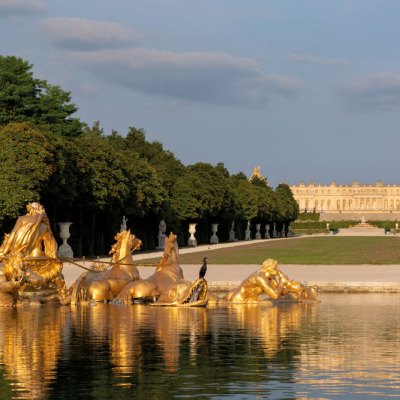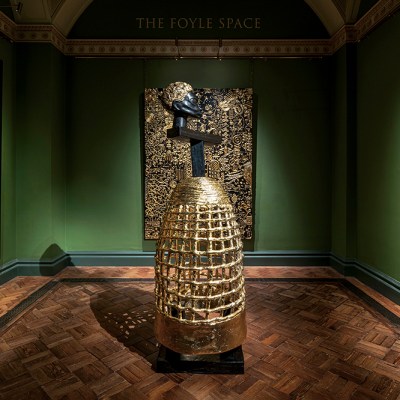‘Men are only as great as the monuments they leave behind,’ Napoleon Bonaparte mused in 1804. While he lacked the aesthetic sensitivity of his collector brother Lucien, or indeed of his collector wife Joséphine, he nonetheless knew that his legacy depended on the arts. Napoleon threw himself into giving Paris an appearance befitting ‘the chief capital of the Universe’. In keeping with his training as an artillery officer, Napoleon overlaid the city with a lattice of roads, bridges, fountains, canals, and three new kilometres of quayside. While functionality was Napoleon’s chief concern, he also studded Paris with monuments to the glory of the Grande Armée. After he had abandoned the idea of simply dismantling and relocating Trajan’s column from Rome, its Parisian riposte, the Colonne Vendôme, was inaugurated in 1810, its bas-reliefs cast from the melted bronze of 1,200 Austrian and Russian canons. New triumphal arches reared up at the place du Carrousel and the place de l’Étoile, and in 1811 Pierre Vignon was commanded to erect a Temple of Glory for France’s military heroes. ‘I wanted Paris to become a city of two, three, four million inhabitants,’ Bonaparte boasted on St Helena, ‘something fantastic, colossal, unknown before our times.’
In the arts, as in every other domain, Napoleon’s reach exceeded his grasp. While the architects of the First Empire give intimations of the Paris of baron Haussmann, scores of projected palaces, Elysian Fields, and obelisks never made it off the drawing board. Some of the most enduring Napoleonic symbols – such as the Arc de Triomphe begun by Chalgrin in 1810 – had to wait decades for completion, and even then appeared in a modified form (Vignon’s Temple of Glory, for example, morphed into the Madeleine church). If political instability is partly to blame, some of the shortfall must be attributed to the Emperor’s own ingrained habits of thriftiness. The beautification of his capital was to be paid for not from state coffers, but from the indemnities extracted from defeated foreign powers, and so construction happened in fits and starts. It was not towering edifices but delicate internal spaces that carried the strongest imprint of the regime. As the art historian Madeleine Deschamps has put it, ‘Empire was more an art of the interior than of building.’
In recent years, political historians have emphasised that the Empire was not summoned into existence by the will of one man but was the work of many hands. Attention has shifted to Napoleon’s collaborators, those erstwhile republicans like Sieyès and Cambacérès who were willing to throw their lot in with Bonaparte as he selectively revived the structures and the trappings of the monarchy. In this perspective, Napoleon borrowed as much as he innovated, capitalising on pre-existing trends. This pattern was also observable in the cultural realm, whose Salons and musical premieres have for too long been written off as a weary propaganda parade. It is true that French artists had to accommodate themselves to the new political circumstances after Napoleon’s coup in 1799, but these circumstances were not merely restrictive, nor did they monopolise creative energies. How far can we subtract the Emperor from the development of the Empire style?
Charles Percier (1807), Robert Lefèvre. Châteaux de Versailles et de Trianon.
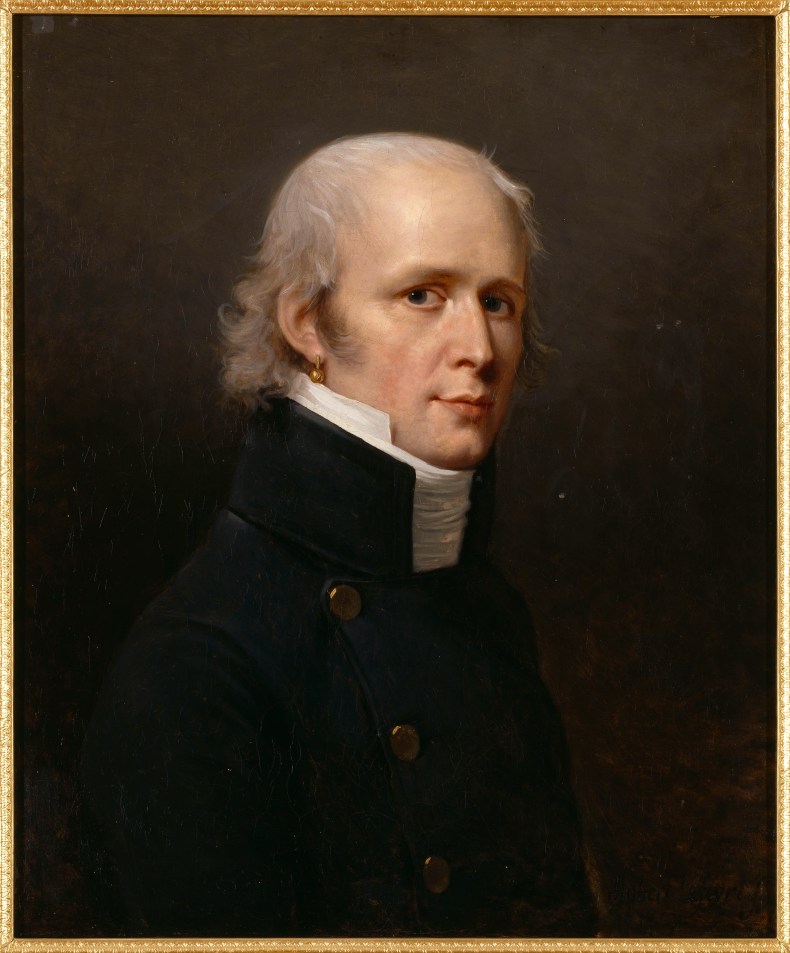
One answer to the question can be seen in the exhibition dedicated to Charles Percier (1764–1838), which travels this month from the Bard Graduate Center to Fontainebleau (18 March–19 June). Percier is an elusive subject; a certain mystery shrouds his political convictions as well as his sexuality (hinted at, perhaps, in his illustrations of a homoerotic symposium in a 1799 edition of Horace’s Epistles). While Napoleon Bonaparte shaped his career, it was in no way subordinate to him. With one foot in the Grand Tour, and another stretching out towards the Great Exhibition, Percier straddles the 18th and 19th centuries. Should he be viewed as the last great court architect, heir of the ephemeral spectacles and royal pageants devised by Gilles-Marie Oppenord? Or rather should we see Percier as a rationalist modern, champion of the industrial arts, and visionary interior decorator avant la lettre?
The exhibition’s curator Jean-Phillipe Garric has long championed freeing Percier from the shadow cast by his long-time collaborator, the architect Pierre Fontaine (1762–1853) – with whom he even shares a tomb in Père Lachaise. Thanks to his memoirs and journal, and the longevity of his career after 1815, Fontaine has tended to upstage his friend and partner. Yet the show and accompanying catalogue makes it clear that Percier’s contribution, while harder to pin down, was disarmingly versatile and consistently inspired. His imagination released a bestiary of griffins, chimeras, sphinxes, swans, and lions into French drawing rooms; from tented rooms and ‘Etruscan’ Sèvres vases, few icons of the First Empire were untouched by his genius for design. In addition to his gifts as a draughtsman, Percier made a signal intellectual contribution to the history of architecture. The successors to his chair at the Institut de France still ritually hand down his ring to a new incumbent, affirming their descent from a revered founder of the École des Beaux-Arts.
Set design for Elisca, or Maternal Love, Act I (1799), Charles Percier, Pierre Fontaine, and Jean Thomas Thibault. Bibliothèque nationale de France, Paris
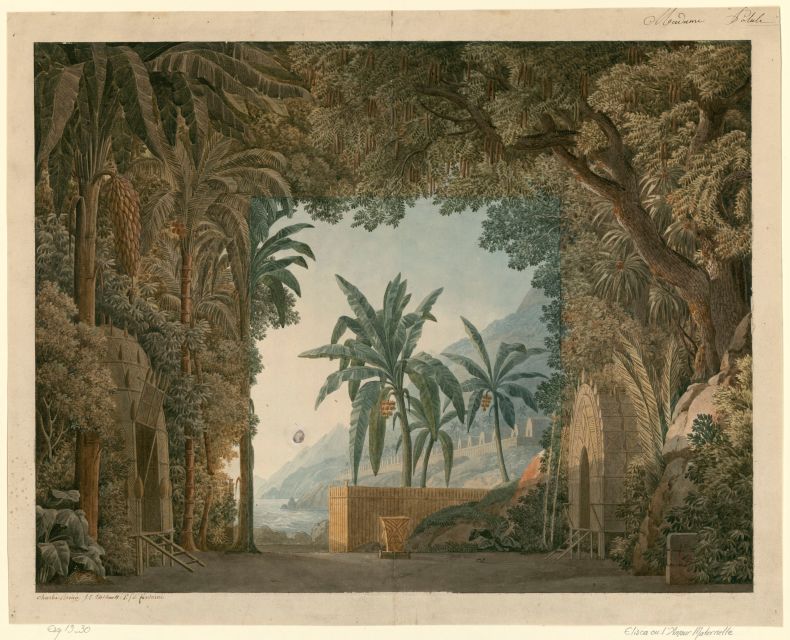
Percier’s imagination, like that of so many French 18th-century artists, was nourished on Italy, where after winning the Prix de Rome he poured over specimens of bon goût between 1786 and 1791. Garric rightly observes there is something Piranesian in Percier’s delight in ornamentation, as captured in his drawings teeming with motifs. In large wash drawings exhibited in the salon of 1791 he assembled ancient fragments as a storehouse of perfect forms available for creative redeployment. But this concern for telling details was already balanced by an awe for the integration of architecture and decoration achieved by Giulio Romano in the Palazzo del Te. Italy taught Percier to think of fixed structures and their flexible contents as a single entity. On returning to Paris Percier and Fontaine were appointed set designers to the Opéra, which gave them a valuable apprenticeship in conjuring up exotic lands and dramatic visual effects. Theatricality became an enduring ingredient of the Percier brand, as witnessed in the glittering mirrors and precious wood veneers fitted in the Platinum Room of the Casa del Labrador in Aranjuez.
In the years after 1795, Percier forged a new stylistic language adapted to the needs of an elite emerging from the rigours of the Terror. Under the government of the Directory, luxury consumption was reborn in chic neighbourhoods like the Chaussée d’Antin, providing a fresh gilding for the stalwarts of the Republic. ‘We saw conspirators who had been drenched in blood,’ recalled Madame de Genlis in her memoirs, ‘sleep on sumptuous beds decorated with cameos representing Venus and the Graces! And we saw suspended above their heads not the sword of Damocles but a little arrow and wreaths of roses!’ While many of the old aristocracy had been pushed into exile, or dispatched to the guillotine, huge fortunes were being won by those who acted as contractors or creditors to the Revolutionary armies. Percier’s early clients included financiers and businessmen such as Gabriel-Julien Ouvrard, Benoît Gaudin, and François-Bernard de Chauvelin, men who had each acquired a hôtel belonging to the former nobility, but which required renovation to bring it fashionably up-to-date.
The fruits of these commissions were preserved in Recueil de décorations intérieures, an astonishingly influential book of plates that took shape between 1801 and 1812. In her catalogue essay Iris Moon underlines that the Recueil was a composite publication, made up of fascicles, which appeared in instalments over 12 years. The plates were acquired either through subscription or from the marchands de nouveautés, enticing consumers avid for evidence of the latest trends. The unfolding sequence of plates offered theatrical, perspectival views of celebrated clients’ interiors, dotted with fashionable accessories: chunky, architectural commodes with bronze mounts; armchairs with curved backs and sabre legs; and that creative centrepiece, the enveloping lit-en-bateau (popularised by Juliette Récamier). In time Napoleon and Joséphine would literally or metaphorically annex these stylish prototypes. One of Percier’s most significant early commissions was the townhouse of General Moreau on the rue d’Anjou. At first Joséphine had copies made for Saint-Cloud after Madame Moreau’s prize pieces, such as her sewing table. After Moreau was accused of conspiring against the regime in 1804, and was exiled to the United States, Napoleon confiscated his possessions and installed them at Fontainebleau
Design for a bedroom for Josephine (c. 1802), Charles Percier. Private collection

Napoleon was therefore less the originator than the inheritor of these fashions. For a publication often remembered as the Bible of the Empire-style, it is curious that Napoleon’s name never appears in the Recueil. The works executed by Percier and Fontaine at the Louvre, which were advertised in the final instalments, treated the state as if it was only the last in a series of patrons. Professional relations with the imperial couple were at first rather fractious. Impressed by their work for other private clients, Joséphine appointed the pair to take charge of her rural retreat at Malmaison. As Vincent Cochet relates in the catalogue, it was not a happy commission. Napoleon bemoaned the cost of their plans and thought the tented vestibule looked like ‘an animal house at a fair’. Their bold schemes for the house fell foul of Joséphine’s trusted Anglophile gardener, Jean-Marie Morel, and her lack of support prompted them to hand in their resignation. Fontaine secretly rejoiced to be free of the caprices of Joséphine, whose ‘desires are orders that one cannot refuse, and whose outcome even the subtlest would be unable to foresee’.
Greater success in the remodelling of Saint-Cloud, however, ensured that Napoleon (now Emperor) promoted Fontaine to chief architect of his household. With Percier now receding somewhat into the background, Fontaine liaised directly with Napoleon and gained a clear view of the prevarications and the parsimony that characterised his attitude to renovating the royal palaces. Fontainebleau gained a throne room, but much of the 17th- and 18th-century decor remained unchanged; Compiègne, by contrast, was a hive of activity, with new decorations completed for the library, the emperor’s bedroom and the empress’s apartments by 1810 – just in time for the arrival of a new bride, Marie-Louise. Some of the most spectacular embodiments of imperial glamour happened in the homes of the wider Bonaparte family, whether the silver salon built for Caroline Bonaparte and Murat at the Élysée palace, or the boudoir of Pauline Borghese in the hôtel de Charost, dominated by a canopied bed framed with four Egyptian caryatids. Percier, Fontaine and associates were becoming a dynastic brand. Ulrich Leben’s sumptuous recent monograph on the hôtel Beauharnais has revealed the vast sums and exquisite care that Eugène de Beauharnais (with the aid of his extravagant mother Joséphine) lavished on the former hôtel de Torcy. The dark luxury of the Turkish boudoir, surmounted by a frieze depicting harem scenes, is the last word in ambient Ottoman fantasy. Frustrated by the spiralling costs, Napoleon confiscated the hôtel from his stepson.
Medal cabinet (c. 1809–19), designed by Charles Percier and made by François-Honoré-Georges Jacob-Desmalter, mounts by Martin Guillaume Biennais after drawings by Dominique Vivant Denon, Metropolitan Museum of Art, New York
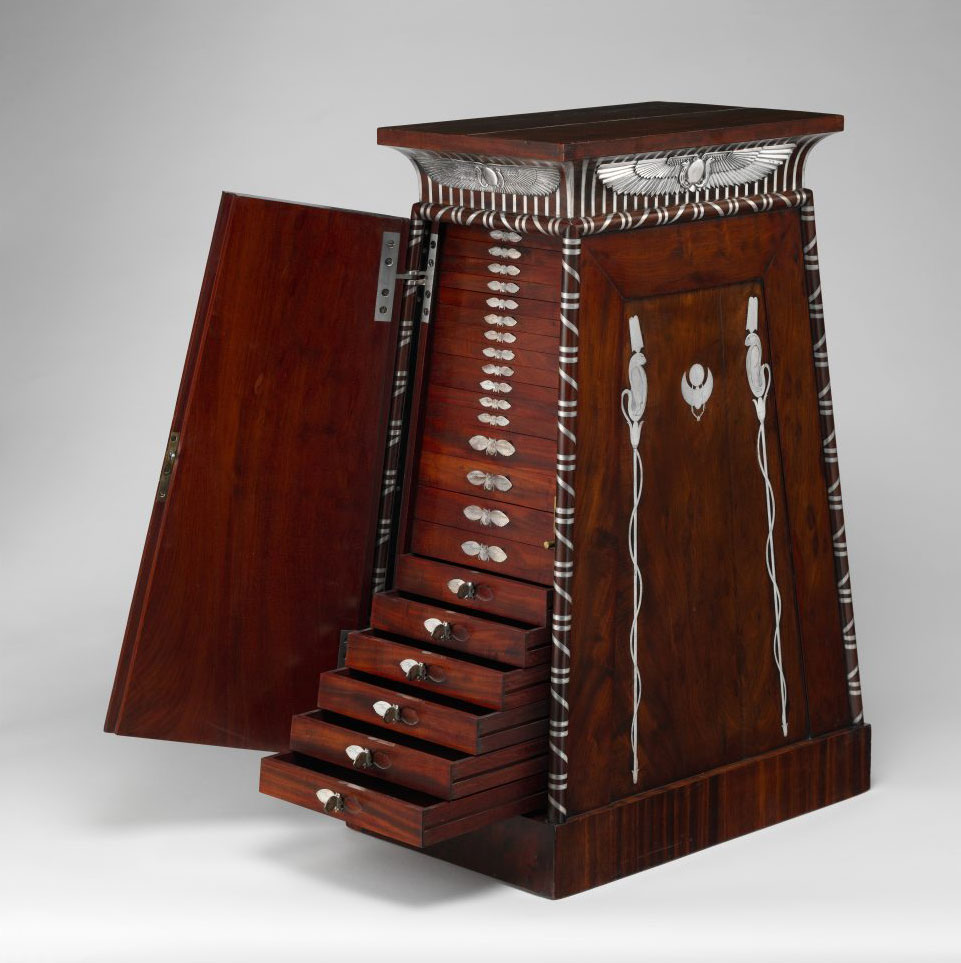
None of Percier’s grand designs would have been conceivable without close relations with the cream of Paris manufacturers. The luxury trades had been thrown into disarray in the 1790s due to the demise of the court, the emigration of their noble clients, and the abolition of the guilds. Enterprising firms, however, weathered these changes, taking advantage of the collapse of old corporate strictures to diversify and expand their production. By 1803 the brothers Jacob owned more than 16 different workshops (including those for joining, turning, sculpting, moulding, and gilding) and employed more than 330 workers. Percier’s close collaboration with François-Honoré-Georges Jacob-Desmalter as the foremost ébeniste of the age was mirrored in the designs he furnished for silversmith Martin-Guillaume Biennnais and for Alexandre Brongniart, the director of Sèvres. More indirectly, the inclusion of precise measurements within the Recueil facilitated widespread copying of his models, generating a rare stylistic coherence across different media. ‘Jewellers, goldsmiths, engravers, cabinetmakers and wallpaper manufacturers drew upon the work of Percier,’ observed the Journal du Commerce in 1805, ‘such that it is not unusual to find in a single apartment a tapestry, a clock, a table service, and a woman’s parure in the same design elements.’
On the one hand, Napoleon welcomed these developments, eager to restore the lustre of the key industries of the ancien régime, such as Savonnerie carpets, Gobelins tapestries, or Lyons silks. The promotion and exhibition of the industrial arts was a key plank in his strategy of economic rivalry with Britain. Yet this same rivalry led to the imposition of the continental blockade in 1806, which sealed off the continent to British shipping, and caused huge problems for firms that depended on imported raw material or foreign markets; Jacob-Desmalter, for instance, exported nearly one third of his production. Loans and additional commissions to supply the courts of the Bonapartes after 1807 could not entirely compensate for these losses. The quality of Empire furniture suffered as craftsman were forced to swap rare hardwoods such as mahogany for indigenous varieties of walnut, cedar, and elm.
Such adaptations underline the difficulty of pinning the Empire down to a single aesthetic. Percier was steeped in the study of antiquity, and believed the principles of taste resembled the ‘general laws of truth, simplicity and beauty’. But he was far from exclusive in his admiration. Unlike the stark geometry espoused in the architectural theories of Jean-Nicolas Durand, Percier dressed his classical structures with a profusion of ornament indebted to the schemes of the French Renaissance. The three volumes of watercolours now held in the Bibliothèque de l’Institut testify to Percier’s fascination with the spatial logics and decorative luxuriance of Fontainebleau. In the 1790s he also assisted Alexandre Lenoir in salvaging the façades of the 16th-century palaces Gaillon and Anet, reinstalling them within the chronological survey of the Musée des Monuments Français. Lenoir’s medieval fragments served as inspiration for the striking polychrome pavilion that Percier erected outside of Notre-Dame for the imperial coronation. Shades of Charlemagne and Saint-Denis were invoked to cast Napoleon as a medieval chevalier.
Even within the ‘official’ arts of Empire a mass of contrary styles flourished, whether the orientalist fantasies amplified by the Egyptian expedition, the Celtic and Bardic sublimities derived from Ossian, or the jousting troubadour school sponsored by Joséphine. Napoleon’s reinvention of legitimacy obliged him to perform his authority with the aid of a bewildering wardrobe of disguises. Architects and artists were commanded to provide the ideal props and stage-sets on which he could strut and strike poses. Roman-revival pageants like the distribution of the Eagle standards typified Napoleonic showmanship and the ongoing quest to scrutinise ancient practices to find some appropriate sanction for the present. Through consulting Percier’s studies entitled Résidences de souverains, Napoleon could compare how previous French monarchs had built and lived, to better formulate his own unique synthesis of monarchical tradition and modernity.
The relationship between Napoleon and his artists was not simply built on coercion, but on mutual calculation and compromise. If he needed them to acquire credibility in the role of sovereign, they also recognised the enormous benefits of state patronage (including a boost to their cachet among private collectors). Beyond that, there was a degree of creative latitude, as the regime co-opted existing fashions as much as it coined new ones. Ephemerality, the curse of Revolutionary culture, continued to mark the Empire, as ambitious monuments were mothballed by the turn of events. Percier and Fontaine’s final proposed masterpiece, a huge palace for the king of Rome on the top of Chaillot hill came with an estimated quote of up to 30 million francs for its construction. With each new sketch Percier and Fontaine produced for the site between 1812 and 1815 the dimensions of the palace, conceived over five floors and rising directly out of the river, dwindled in size; by the time of the battle of Waterloo the palace was scarcely more than a quaint garden pavilion.
Washstand (1800–14), designed by Charles Percier with mounts by Martin-Guillaume Biennais. Metropolitan Museum of Art, New York

Yet while time was up for the Emperor, there was no Waterloo for the Empire style. Fontaine’s architectural behemoths were put on ice but through the publication of the Recueil, Percier’s design vision had infiltrated homes throughout Europe and across the Atlantic, even among those hostile to the Empire. French craftsmen reproduced his aesthetic ideas in interiors from Charlottenburg in Berlin to Hampton House in Baltimore, from Rosendal palace in Sweden to Capodimonte outside Naples. Napoleon’s territorial conquests proved less tenacious than the triumph of taste pulled off by Charles Percier. As the Emperor pined for his lost metropolis on St Helena, he could take comfort in the portable memorials of his reign: the yew and silver washstand (athénienne) crafted by Biennais following a Percier model; or the 72 dessert plates from the Sèvres Service des Quartiers Généraux, which formed a painted travelogue of his campaigns. But he also grumbled in exile at the memory of having paid 130,000 francs for a suite of Jacob furniture, ‘all of it made to order’, for his salon on the rue de la Victoire nearly 20 years before. The one-time master of Europe was pained to admit he had also been a fashion victim.
‘Charles Percier: Architecture and Design between Two Revolutions’ is at the château de Fontainebleau from 18 March–19 June.
From the March issue of Apollo. Preview and subscribe here.
